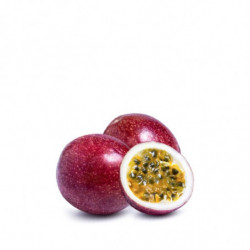
La ciruela blanca tiene una piel de color amarillo pálido o verdoso, con manchas rojizas o moradas. Su pulpa es jugosa, dulce y aromática, de color amarillo claro o blanco. Su hueso es pequeño y se desprende fácilmente de la carne.

Passion fruit or maracuya is a tropical and exquisite fruit characterized by its juicy and aromatic pulp, which comes in yellow or purple, and its crunchy and edible seeds. Its flavor is sweet and sour at the same time, with a citrusy touch reminiscent of lemon or orange. It is a highly nutritious and healthy fruit, rich in vitamins, minerals, and antioxidants that benefit the immune system, digestion, vision, and skin. Additionally, it has relaxing and sedative properties thanks to its content of passiflorine. It can be consumed fresh or used to make juices, smoothies, jams, sauces, desserts, or cocktails. Its aroma and flavor combine very well with other fruits such as mango, banana, coconut, or pineapple.
 Security policy
Security policy
Website built using newest versions, SSL protocols, Secure payments
 Delivery policy
Delivery policy
Receive your order in 24-48h
 Return policy
Return policy
100% Satisfaction guarantee

Guarantee safe & secure checkout
Passion fruit, also known as maracuyá, is an exotic fruit native to South America, specifically from the tropical forests of Brazil, Paraguay, and Argentina. Currently, it is cultivated in many tropical and subtropical countries worldwide, including Africa, Australia, India, and some Southeast Asian countries.
Passion fruit is an oval or round-shaped berry, approximately 4-5 cm in diameter, which can vary in color from pale yellow to dark purple. The pulp is juicy and contains numerous black seeds, which are edible.
In terms of gastronomy, passion fruit is a versatile ingredient used in a wide variety of dishes, both sweet and savory. It is especially popular in desserts, where its sweet and slightly acidic flavor complements other ingredients such as chocolate, coconut, and cream cheese. It can also be used to make beverages like smoothies and cocktails, as well as a dressing for salads and meats.
In history, passion fruit was known to South American indigenous peoples long before the arrival of Europeans. It was discovered by the Spanish and Portuguese during the conquest of America and quickly became a popular fruit in Europe. Nowadays, it is a significant crop in many tropical and subtropical countries, exported worldwide.
In terms of health, passion fruit is rich in vitamin C, vitamin A, iron, and fiber. It also contains antioxidant compounds that can help protect the body against cellular damage and inflammation. Additionally, certain compounds found in passion fruit have been shown to have sedative and anxiolytic properties, which can help reduce stress and anxiety.
Regarding agriculture and botany, passion fruit grows best in warm and humid climates, with an optimal temperature of around 25-30°C. There are several varieties of passion fruit, including the yellow variety, the purple variety, and the granadilla variety. Each variety has unique characteristics in terms of flavor, color, and pulp texture. Passion fruit is a seasonal fruit, typically available from late summer to early autumn.
Ingredients:
Preparation: